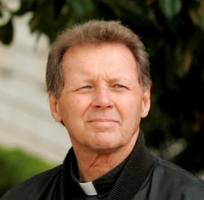CATHOLIC? EX-CATHOLIC? WANNABE? ANTI-?
SEE THIS MOVIE!
I always knew there was a place for a woman
at the altar besides in a coffin.
--Newly
ordained woman priest

When I was a young girl, I used to help after school by banging erasers together to get the chalk dust
out. One day the Catholic nun who was my teacher said, "Let's stop now. I want to show you
something."
We
walked across the empty schoolyard, she in black habit and veil, a long rosary
swinging from her waist, I in a uniform blue jumper and white blouse, hurrying to keep up with Sister's long stride. We entered the
parish church by a side door.
The
simple stone chapel that had served the town for decades was being absorbed
into a modern design. Inside,
by the dusty half-light of a building under construction, I could see a brand
new stepped altar that would be visible from three sides by the congregation. I
followed Sister all the way to the front, walking around scaffolds. When she bid
me mount the altar with her, I was astonished.
This
was before the momentous changes of Vatican II, a time when a young girl knew
she had no place on the altar where mass was said. I had memorized the Latin responses, but unlike my brothers, I would never serve mass. I was not a boy.
Inside the new parish church, I hesitated about stepping on the altar. "It's all right," Sister said. "It's not consecrated yet."
Vatican
II called on all members to participate more fully in the life of the Church, carving
an opening for the voice of the laity and communities of the faithful to be
heard, although women priests was not on the agenda. Nevertheless, by showing how the Church might remain the
same even as it changed, Vatican II opened the door to fresh thinking that even
today's conservative hierarchy is finding hard to overcome. And let's not forget the beauty of
synergy: Vatican II's effects unfolded at the same time a wave of feminism was
breaking over much of the world.
 Pink
Smoke Over the Vatican, filmmaker Jules Hart's compelling new documentary,
uncovers the history of women priests in the Catholic Church from its
beginnings, showing how an increasingly patriarchal
institution squeezed out women from formidable roles over the centuries. Churchmen wrote laws that said an
exclusively male priesthood was so central to doctrine that it was a given, a
rule that could not be broken. Nevertheless, some clear-eyed bishops have begun
again to ordain women, believing that the unmistakable interior call to the
priesthood, a vocation, is not restricted to one gender.
Pink
Smoke Over the Vatican, filmmaker Jules Hart's compelling new documentary,
uncovers the history of women priests in the Catholic Church from its
beginnings, showing how an increasingly patriarchal
institution squeezed out women from formidable roles over the centuries. Churchmen wrote laws that said an
exclusively male priesthood was so central to doctrine that it was a given, a
rule that could not be broken. Nevertheless, some clear-eyed bishops have begun
again to ordain women, believing that the unmistakable interior call to the
priesthood, a vocation, is not restricted to one gender.
Where
there is smoke, of course, there is fire. The bishops who ordain women -- they can be counted on one hand -- are considered renegades. As insistence grows, especially from the laity, to ordain women
openly and with joy, the Church digs in its heels, lashing out at
the new priests and their supporters.
When she was ordained, a South African nun who went to jail under apartheid for quietly accepting all races into the school of which she was the principal, was kicked out of the Dominican community that had been her home for decades.
 Fr. Roy Bougeois, awarded the Purple Heart for military service in Vietnam and a Maryknoll priest for almost forty years, is being excommunicated for his support of the women, the most severe punishment the Church can inflict.
Fr. Roy Bougeois, awarded the Purple Heart for military service in Vietnam and a Maryknoll priest for almost forty years, is being excommunicated for his support of the women, the most severe punishment the Church can inflict.
This
is a strong film, although for me, using the stereotypical "Pink" in
the title is a minus. So is a
brief section, too facile, I think, suggesting priests' sex abuse crimes would
have been fewer or non-existent had women priests been accepted in the
Church. I believe more
gender balance in the priesthood would obviate many difficulties, enabling it
to minister to, and with, the faithful better. The sex abuse crimes are not about
"men," however, but about the arrogant, hurtful behavior of some priests
and a hierarchical system riddled with corruption and impunity.
 You
will learn from Pink Smoke and even laugh with it. No
matter what you bring to the movie from your own history, it's difficult not to
admire the women aspiring to ordination, to answering their call, and their Catholic brothers who
support them.
You
will learn from Pink Smoke and even laugh with it. No
matter what you bring to the movie from your own history, it's difficult not to
admire the women aspiring to ordination, to answering their call, and their Catholic brothers who
support them.Pink Smoke Over the Vatican - Eye Goddess Film
eyegoddess.com/pink_smoke.php






